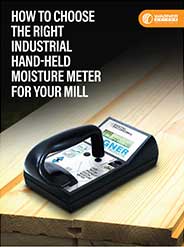Wood Moisture Video Series for Woodworking
Hosted by Charlie Phillips, Assistant Professor of Wood Technology, Pittsburg State University
Wagner Meters and Charlie Phillips from Pittsburg State University are proud to present this Webinar Training Series for woodworkers and wood flooring professionals.
This webinar training series provides insight about wood moisture content (MC) and its effect on wood products. Woodworkers and wood flooring professionals must have a thorough understanding of the relationship between wood and moisture in order to prevent costly mistakes.
Defining Wood MC
MC is the weight of the water in a piece of wood versus the oven-dry (or moisture-free) weight of that piece of wood. See the formula below to calculate MC:

It’s universally understood that the success of any wood-related project depends on taking accurate readings of the wood’s MC. Once you correctly measure for MC, you then need to know whether or not that MC is within the acceptable range before proceeding.
For example, the acceptable range for wood used in flooring or to build a table is generally 6% to 8% MC. MC outside that range can result in damage to the flooring or table as the MC acclimates to the relative humidity (RH) or moisture in its environment.
How Moisture Can Damage Wood
All wood material is three dimensional. Knowing how wood shrinks and swells along these three dimensions can help woodworkers and wood flooring installers avoid potential problems.
The amount of shrinkage or expansion varies from species to species, but generally wood shrinks or expands about 1% in size across the grain (thickness and width) when the MC changes 4%. Wood, however, barely shrinks at all along the grain (length-wise), even with large moisture changes.
While a 1% shrinkage on furniture or wood flooring – which occurs with a 4% MC change – seems very small, maybe only several thousandths of an inch, such a change can easily lead to gluing problems, especially cracks and joints, after the furniture, cabinets, or wood flooring have been manufactured.
In a piece of furniture or cabinet, 1% shrinkage or swelling can result in poor fitting drawers and doors, as well as poor fitting joints. Finished cracks and warp can also develop with 1% shrinkage.
When wood flooring is exposed to excessive moisture or to very dry conditions, the dimensions of the wood will expand or contract accordingly. When the rate of expansion or contraction changes too drastically, wood flooring will show some tell-tale and potentially problematic signs.
For instance, even a change as small as 1/32” per 2” board multiplied across an eight-foot room equals 1 ½” of gapping or swelling.
Acclimating Wood
Wood always acclimates to its environment. When building tables, fine furniture, or installing a wood floor, a woodworker or flooring installer needs to allow the wood to acclimate to changes in MC. If not, the wood can either swell or contract, depending on the relative humidity (RH) in the air, and that can cause problems. That’s why it’s critical to allow wood to acclimate in a climate-controlled location for several days, or even several weeks, before using it.
When wood acclimates, it reaches what is referred to as its Equilibrium Moisture Content or EMC. This means the moisture inside the wood reaches a balance or equilibrium with the RH in the air and the temperature of the wood’s surrounding environment. EMC is that point when the wood neither gains nor loses moisture. It stays that way as long as the RH and temperature of the surroundings are not changed.
If the RH in the air is 40% and the temperature 60° F, for example, the wood will eventually attain a MC of 8%. That 8% is the EMC – it describes what percentage of the wood’s mass is made up of water. More specifically, it means there are 8 grams of water in every 100 grams of wood.
Here are some key values of RH and corresponding EMC every woodworker or flooring professional should know:
- 6% EMC corresponds to 30% RH
- 9% EMC corresponds to 50% RH
These two values are typical interior values for heated and air-conditioned offices and homes in most of North America. These values apply to wood used by woodworkers and wood flooring professionals.
In cold weather climates when a heater is running, interior conditions may be even drier than 6% EMC unless the air is humidified. On the other hand, in humid summer months, especially without air conditioning, conditions in homes, offices, and manufacturing facilities may sometimes exceed 9% EMC.
MC Management
Industry experts agree. They say a moisture meter is critical for avoiding costly mistakes that can affect overall quality and durability of a woodworking or flooring product. In fact, they note that 75% to 80% of all wood manufacturing and quality problems are MC related.
In fact, any woodworker or flooring professional who failed to use a moisture meter and later encountered moisture-related problems with the finished project – such as shrinkage or swelling of wood, cupping, warping, cracking and crowning of the wood, or even surface finishing problems – will tell you a moisture meter is necessary.
Another important thing to note is that the surrounding environment causes wood to constantly lose or gain water. To avoid major problems after the work is completed, woodworkers and flooring professionals must first know what the wood they’re working with will eventually equalize to. They can only do this with an accurate moisture meter.
The wood used in fine furniture or wood flooring is often expensive, so failing to determine beforehand if the wood is too wet or too dry may result in a costly mistake. In that regard, a moisture meter is good insurance and a cost-saving management tool for woodworking and flooring projects.
Spotting potential moisture problems and taking the proper steps to avoid them is critical to the success of any woodworker and wood flooring professional.
Here at Wagner Meters, we welcome your questions and encourage you to call us at 800-634-9961.




Jonathan:
Thanks for the comment. It could be all of the above or none of the above. You should contact NWFA.org and have one of their certified inspectors come out and take a look at it if it is an issue.
Thanks,
Jason
I purchased a Cali Bamboo flooring from Lowes Hardware Store. Before installation of my flooring, I took home a wood sample and soak it in water for 3 days, the wood was still to hard and it did not retain any water. But as of today, the plank where it was connected started to swell up. Was it still the moisture on the wood? and the glue started to sneak up between the wood. What should I do ? Did the installers used a good meter product ?
what about shell mc verses core mc? emc is reached when shell mc and core mc are the same. how does your equipment measure shell verses core? We currently use a Delmhorst pin meter to do this on aromatic cedar up to 10/4 thick. How does youe equipment do this?
All of our products don’t distinguish between shell and core. Wagner meters measure past the surface as far as an inch into the material. So, in essence, the reading provided is an average moisture content under the meters up to an inch penetration.
When we dry wood it is essential there isn’t a large difference between the core and shell as the shell provides a conduit for moisture from the core to be released and a large difference can break the conduit and our drying process comes to a stop until we wet the shell enough to begin drying again. How does you system compensate for this?
I think it’d be best if you could give us a call so we can discuss this further. You can reach us at 1-800-634-9961, Monday through Friday between 7:30 am and 4:00 pm PT.
I work for a Floor Covering company. We mainly use unfinished 3/4 thick wood and engineering pre-finished. I am the quality control rep. I need your advise for a moisture meter, humidity meter and any other meter that could help me to make my job more accurate and helpful in my everyday duty.
Thanks,
Joseph
Joseph,
Your best bet is to arm yourself with an MMC220 wood moisture meter, TH200 thermohygrometer for documenting the RH% and temperature in the air, and our WOODH2O smart phone app available for FREE. Using the information from the TH200, you input it into the WOODH2O app to calculate equilibrium moisture content. Using the MMC220, you get the actual finished flooring/subfloor MC%, and compare it to the EMC. This allows you to know if the product/products have acclimated to the environment. Should there ever be a problem with the floor after installation, having all of this information in the job file may also make it easier to diagnose the problem.
Thanks,
Jason